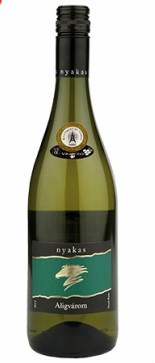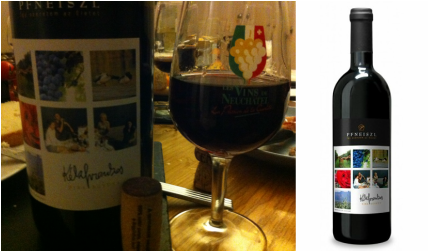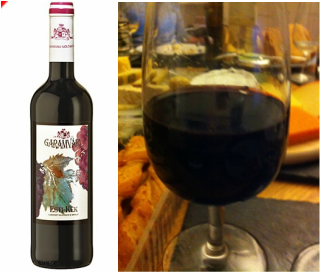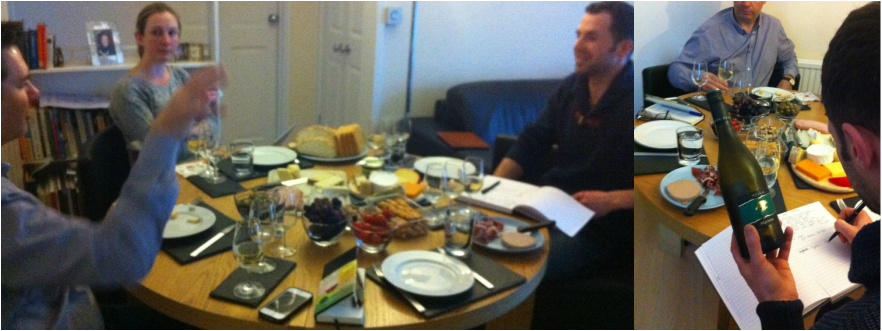
Finally, this century, I got to taste a "Tokaji 5 Puttonyos" and realised that I'd been missing out on a wealth of amazing wine. Starting my wine studies, I learned more, and last year, I finally made my first of 3 trips (so far) to the Hungarian capital, Budapest. I also met some great Hungarians.
I haven't yet found myself in Hungarian wine country, but the wines I've tasted had me intrigued.
The language and culture are different to much of Europe (eg it's not normal to clink glasses when toasting your drinking partner in Hungary). And the rich wine tradition, dating back to the Roman empire, has delivered some unique and very different wine styles to those you'll find on your local supermarket shelves, as well as internationally recognised varietals. I wanted to share this diversity with my Purple Teeth readers.
Thank you very much to Bálint Takács of The Hungarian Wine House for providing the wines we researched for this article. He founded his company in 2008. Now offering a selection of over 70 Hungarian wines and spirits to represent the best of what the country has to offer, Bálint personally controls his range by regularly visiting the wineries. With a minimum order quantity of just one bottle, you can feel free to follow up and buy a bottle of whatever takes your fancy. It'll be with you in two days or less.
Bálint kindly provided a mixed case of wine, so I felt it was only fair to enlist some extra help in reviewing the bulk of the bottles. As well as Mr Purple Teeth, I invited Jo from another wine blog, Perfect Friday Wine and Aurimas, one of my friends from WSET school, to help taste and review. Jo and Aurimas are studying for the next level of WSET qualification, the seriously tough Diploma, so they were more than happy to try some new wines.
But first a few facts about Hungary and it's wine (don't worry, there's no test at the end)
- The Hungarian word for wine (BOR) is one of only 2 in European languages that doesn't derive the word from latin roots
- Sparkling, red , white, rosé, and of course dessert wine styles are all produced, from indigenous and international varieties
- There are 22 appellations (or named regions) within Hungary, each offering it's own character to the wines
- The climate is basically regarded as "continental", but large bodies of water, such as Lake Balaton and Austria's Neuseedlersee, very close to the Hungarian border, provide moderating influences to some of the wine regions while the Carpathian and Alpine ranges help to keep things temperate
- A wide variety of soil types are present including everything from volcanic basalt, to chalky, through sandy.
- The famous Bull's Blood (Bikavér) wine is thought to have fortified the defenders during an invasion in 1522. The wine was given the name due to a widespread belief that bull's blood was indeed a secret ingredient in the wine.
- In 1997, Hungary's first Districtus Hungaricus Controllatus - DHC was created (similar to the French Appellation d'Origine Controllée (AOC), enacting the rule specifying that Egri Bikavér must contain 3 out of 11 traditional grape varieties.
- The sweet wine Tokaji is so renowned, it even gets a mention in the Hungarian national anthem. It's been made since 1571
- While wine-making suffered during the communist period, the last 20 years have seen an immense upturn in the quality of winemaking across Hungary, and many winemakers are investing in new technology and equipment to produce fine wines with a unique style and history
Now what really matters - what does it taste like? We're still only scratching the surface here, but open your mind, explore something different and let us whet your appetite to try the wines of this intriguing nation.
The Whites

The grape variety is native to the area around Lake Balaton, and it produces wines that are great as an aperitif, as well as matching well with soft cheese. Light bodied and relatively low in alcohol (12%), I found it very light and easy to drink. The flavours were comice pear, lemon and some elderflower. The scent of the wine is really intense and leaps out of the glass at you before you even taste it, although the flavour is slightly less intense than the nose suggests. We all noted some petillance in the wine - a slight spritz when opening (and re-opening) the screwtop. The summary view from all of us is that this is light and fresh with pleasing acidity, and would be great on a summer evening. It would probably appeal to drinkers of Muscadat, Picpoul or Albariño who are looking for something different with a floral quality.
Luckily, I got to taste most of the wines again the day after. This one still had a good intense bouquet and was very pleasant.

With several international awards and a name (Aligvárom) which translates as "I can't wait", this wine created high expectations.
Fortunately it lived up to all expectations and beyond. Pale straw in colour, it's flavours are much more intense than the colour suggests. There are really intense aromatics here, with lime and tropical fruit flavours. This was a resounding favourite among the whites on the night. Mr Purple Teeth thought it was a pineapple explosion and instructed me to place an order. As well as lime and tropical hints on the nose, we also found some peach flavours. Crisp and refreshing yet with a smooth finish with a silky or somewhat oily texture on the palate, there was a lot to interest us in the glass. Paired with a selection of charcuterie and strong cheeses, the wine faired well.
Going back to taste the remainder on day 2, I was glad I had it all to myself. The aroma seemed less intense and some of the tropical flavours had decreased but it was still delicious, rich and silky, with hints of grapefruit on the finish. The body and mouthfeel were still full and satisfying and I was sorry we had drunk so much the previous evening. This was definitely the bottle I'll be buying again, and no doubt my drinking partners might buy some too. If you've never had a Hungarian white wine before, why not start here. It's the cheapest one of the bunch too.

Hailing from Eger, the home of perhaps Hungary's most renowned red "Bull's Blood" (Bikaver), this dry white from the Leányka varietal or "Eger’s Maiden" is very popular in Hungary. Described as "always fresh, crispy and fruity. Abundant fragrances of flowers and fruit. A young pretty wine with long after taste" we were surprised to find this was the least popular of the whites we drank.
This wine really had us all stumped. Although not unpleasant, we were almost tempted to declare a fault, because the cork looked a little weird. This was just an excuse because the 4 of us found it so hard to name the flavours in the wine.
Mr Purple Teeth found almond marzipan flavour. It's full bodied - an interesting conversation piece
I found the nose interesting and baffling. Pretty full-bodied with not much fruit on the palate, I imagined there was perhaps oak or lees stirring in the wine making process. We all found it worked better when paired with food, particularly ham and olives and even worked well with Brie de Meaux, a fairly pungent French cheese.
Jo felt the texture was a little syrupy and that the acidity faded too quickly - maybe a little flabby, she thought. I'll bow to her higher studies.
Aurimus wondered if the wine being a 2011 had just lost some of it's freshness. In any case, it provoked interesting and prolonged discussion.
On the 2nd night it was just as intriguing. It was still incredibly challenging to name the flavours, but perhaps it was something nutty or a hint of spicy ginger. There may also be some honey here. It's got a lot of body and is quite unusual, so if you like a challenge, give it a go. You'll be sure to baffle your wine-snob friends.
A little bit of sparkle

Produced on the Garamvári Estate, this wine was commended by the 2013 International Wine Challenge.
It was going to take something special to convince Mr Purple Teeth to like sparkling wine. It's not something he indulges in or enjoys, and this sadly did not prove any more successful.
Jo, Aurimas and I all instantly tasted a surprisingly dominant apple dominant flavour and aroma. There was something like yeasty, buttery pastry and baked fruit, a little like a fizzy apple pie in the glass. It's got great mousse, and refreshing acidity, but lacked some of the complexity of Champagnes. Jo is a real fan of English sparkling wine and felt like this didn't deliver on the palate what the nose had promised. All in all, it was a decent fizz, but not one we'd be likely to choose again.
The Reds (let's call it Vörös Bor)

First on the list was Pfneiszl Kékfrankos - Together Again Organic 2011 (£12.50 13% abv) from the Sopron region. It is our first of two Blaufränkisch wines. Sopron is a city in the west of Hungary, sometimes referred to as Hungary's most faithful city since it opted to stay in Hungary rather than join it's neighbouring Austria in 1921. On the south bank of the Neusiedlersee (a renowned Austrian wine region) the winery has been growing organically since 2006, powered by youthful family members and winemakers Birgit and Katrin, both in their 20s.
My learned colleagues were unsurprised to hear that we had young winemakers at the helm. It's very much a "party" style red wine in that it's a huge fruit bomb, almost Ribena like with blackcurrant, fairly light bodied and has little to no noticeable tannin. This makes it really quaffable, and there's some smoky flavours and a hint of spicy eucalyptus. Good acidity makes it very juicy and that helped by the fruitiness with lots of soft red cherries, maybe some raspberry, redcurrant and blackcurrant. If you're a fan of young Gamay wines and Beaujolais, you should be trying this. The fruit aromas are as prominent as the flavours and it's really food-friendly. Jo declared this dangerous, because you could easily drink bottles of it before realising it's 13% alcohol, it's just so juicy.

Szekszárd is famous for it's full-bodied and spicy reds, aided by it's long hot summers and mild winters. From here we discovered another delicious Kékfrankos and one that's very different in style: Pastor Kékfrankos Barrique 2011 (£14.20 14% abv)
New in, and already out of stock and no surprise, because it was a winner with our team of 4 reviewers.
Grapes are hand picked and carefully selected, and the new wine spends 12 months in brand new small oak barrels (barriques). It's clearly not a volume product. The intention is maintaining quality.
Again, like the organic offering, this is a red with very low tannin, which Jo and Aurimas felt was a little odd in such a big wine, giving a mouthfeel that lacks the texture of other robust, fruity reds. Despite that, they did enjoy drinking the wine when they took their analytical hats off. Mr Purple Teeth really enjoyed it even though he's a huge fan of tannic wines.
We felt that it might appeal to Syrah and Shiraz drinkers given it's got lots of deep black fruits, black cherry and some chocolate and coffee notes as well as something very savoury. It's soft, juicy and very easy and appealing to drink. If you'd like a wine to pair with red meats but perhaps aren't a huge fan of red wine because of the chewy and drying tannin, you'd be well advised to try this one, so put your name on the waiting list for the next vintage.

Although he felt it wasn't quite as complex as a Bordeaux wine, he enjoyed the full body and rustic blackberry and plum flavours.
I enjoyed this wine more than I expected to, since Bordeaux blends often leave me cold, being too tannic. I actually drank the remainder of the bottle to myself over the course of the next 2 nights and found it opening up more revealing blackcurrant flavours and lots additional spiciness and coffee hints. This suggests the wine would age well for a few years, if you had the patience to hang on to it.
It was very pleasing with strong hard cheeses and had great acidity and tannin in perfect balance.

With a Decanter wine awards commendation to it's name, and based on Kékfrankos, the Hagyamási Bull’s Blood we tasted is a cuvée blend, matured in oak barrels for over 12 months. Eger’s highly prized south-facing Eged Hill has perfect vine growing conditions.
This was a serious wine and it was no surprise to me that it was Mr Purple Teeth's favourite wine of the evening, with it's dark fruits, full body and smoky tones.
It was Jo's favourite of the reds too. She loved the long finish and the spicy notes on top of the dark cherry flavours. She ruled it "great" and took the rest of the bottle home to share with her husband. High praise when there are 9 bottles to choose from...
Pleasant velvety tannins, ripe plums and smoky hints created a very well balanced wine. There was a lot of tannin but the juicy acidity prevents this from feeling drying.
At the end of the evening we had a great appreciation for the whites and reds of Hungary, and were ready for something a little sweeter. As we'd all tasted the "traditional" Tokaji sweet wines, we were given something a bit different to pair with our home-made Lithuanian dessert of Tingynis.
Something sweeter
 The sweet wine with it's home made dessert.
The sweet wine with it's home made dessert. Tokaji Fordítás is another local speciality. The pressed aszú berries are filled up again with grape must (freshly pressed unfermented juice) to dissolve the remaining flavour and sugar contents of the berries, creating a sweet wine with a bit more tannin and lower level of sweetness.
This was like a glass of sweet orange marmalade - very textured from the tannin, good acidity and freshness, with flavours of orange peel, honey and dried fruits. Mr Purple Teeth found a hint of an orange muscat, while we can't quite work out what Jo meant when she sensed a hint of tequlia. Perhaps it was the fresh lime flavours, mingling peach and lemon. It's sweet but not too sweet.
On the second night this was equally appealing. I had it with some duck liver parfait on toasted brioche and it was really a perfect match. A sweet wine but not so sickly sweet that it overpowers food, it's a great introduction to the sweet wines of Tokaji for those who haven't yet had the pleasure.
For those who don't like sweet wines to be too sweet, it's just perfect. On the third night, it was just as delicious with less indulgent jaffa cakes. Simply divine. If you've never before tried Hungarian wine, you really owe it to yourself to try one of these historic and iconic Tokaji wines. You don't know what you're missing.
I look forward to reviewing another unusual white varietal, a semi-sweet Furmint and a pure Cabernet Sauvignon over the coming weeks and months - the three bottles we didn't get to during our tasting evening.
Please feel free to share your thoughts and experiences with Hungarian wines. We'd love to hear what you think.
Egészségedre! (As they say in Hungary).
Cheers!
| PS If you're interested in learning more about Hungarian wine renaissance and it's different regions, there aren't many books out there, but I've included a link to one that has a great appendix and is available in kindle edition. | |



 RSS Feed
RSS Feed
